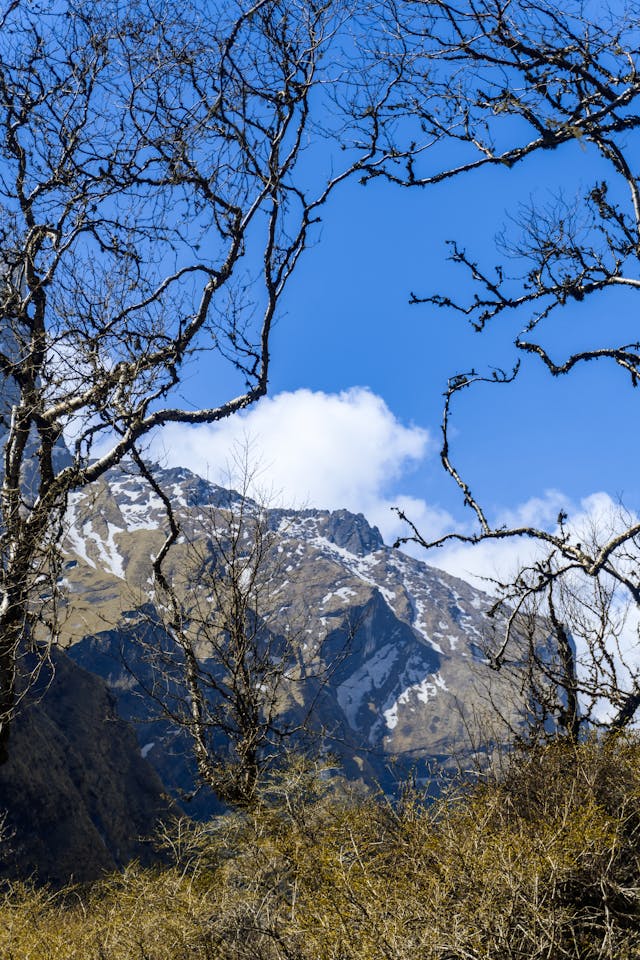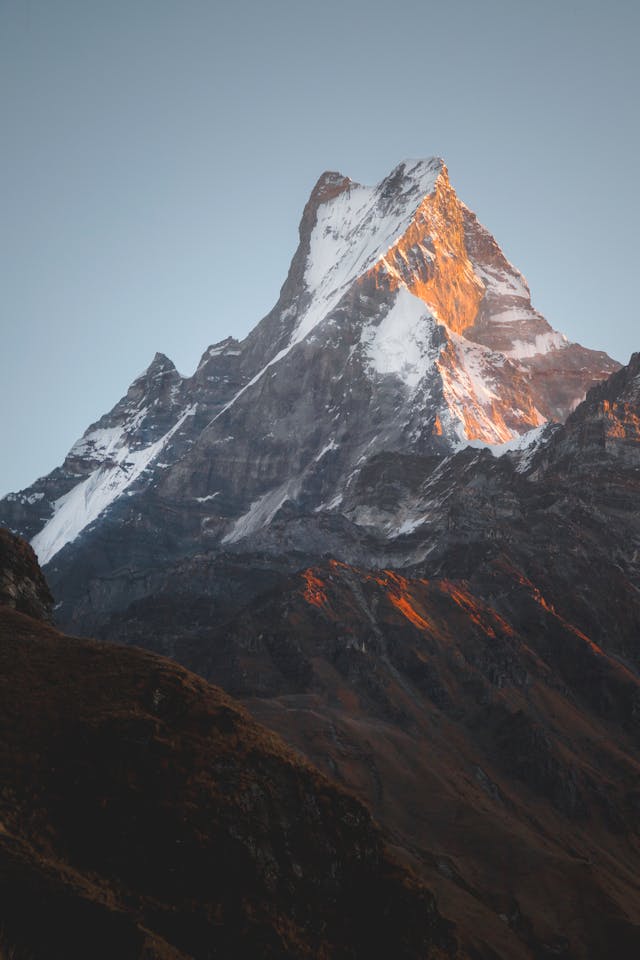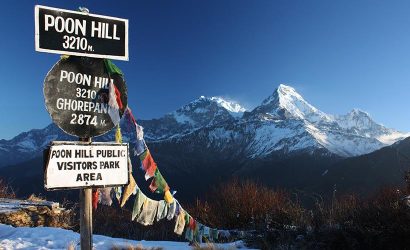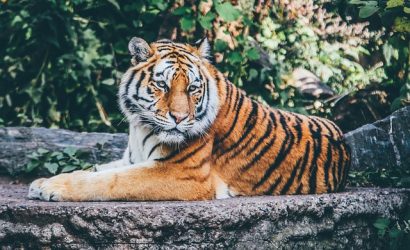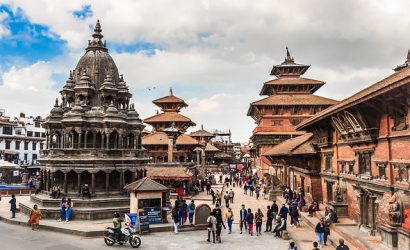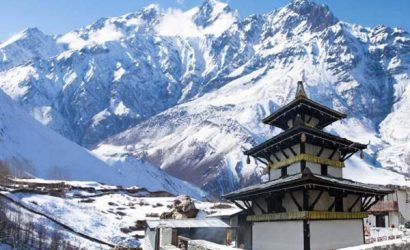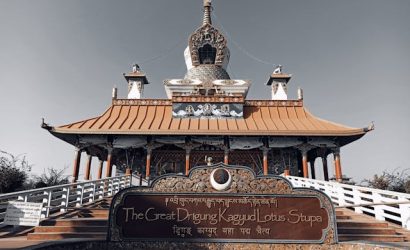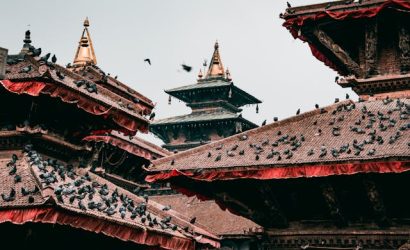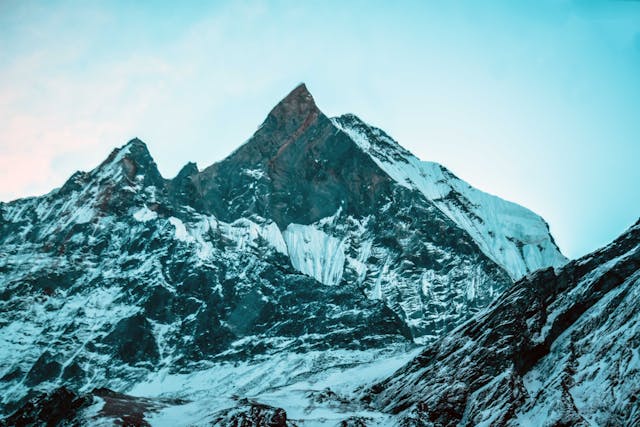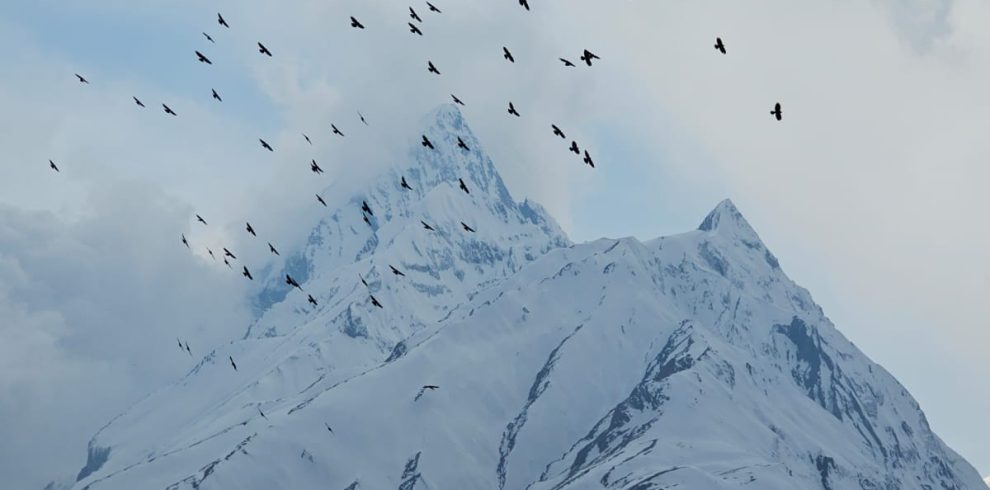A relatively new Annapurna trek—shorter and slightly challenging with amazingly close vistas of the popular peaks in the Annapurna range.
-
Annapurna
-
4,500m / 14,764ft
-
B|L|D on Trek, |B| in Kathmandu & Pokhara
-
Teahouse & Hotel
-
Private Vehicle & Tourist Bus
Overview
The Mardi Himal trek offers a taste of wilderness and a sense of solidarity with nature. Starting from Phedi, the trail gently ascends through paddy fields, lush rhododendron forests, and communal villages. It climbs along stone-paved paths and intersects villages inhabited by the Gurung, Tamang, and Magar communities. As you approach Mardi base camp, greenery becomes scarce, but the sight of Machhapuchchhre (Fishtail) and Mardi peak on the horizon invigorates trekkers. From the High Camp viewpoint, you can see Himchuli (6,441m), Annapurna III (7,555m), Gangapurna (7,454m), Machhapuchchhre (6,997m), and Mardi (5,553m), along with rare animal and bird sightings.
A significant part of the trail lies within the biologically diverse Annapurna Conservation Area, frequented by rare bird and animal species. While several trails lead to the Annapurna Base Camp, the Mardi Himal trek stands out with its distinct charm, seclusion, and relatively easier trail, appealing to trekkers of varying experience and skill levels.
Rewarding mountain views within a short moderately challenging trek
- The astounding Mardi viewpoint that places you right in front of Himchuli (6,441m), Annapurna III (7,555m), Gangapurna (7,454m), Machhapuchchhre or Fishtail (6,997m) and Mardi (5,553m). Mt. Machhapuchchhre seems incredibly within reach from here.
- Cultural exploration at villages like Dhampus and Deurali that are beautifully placed in front of pleasant panoramic views
- The Mardi Himal Trek is relatively less crowded offering a quieter and more relaxed trekking experience with serene camp locations
- Plenty of walking through charming forested trail is a definite highlight, especially lush Rhododendron forests appearing quite vivid during springtime
- Wildlife: Traverse through beautiful rhododendron forests also home to a diverse range of wildlife, including birds, butterflies, and occasionally, rare species like the Himalayan black bear and musk deer.
Itinerary
A representative from Magical Nepal receives you at the airport and accompanies you to your hotel. You may sit back and relax. Later, in the evening we meet you at the hotel to brief you on the plans for the trek. Overnight in Kathmandu.
We board a tourist bus to Pokhara in the morning for a drive along the Prithvi Highway. The Trishuli River along the highway, roadside markets, farms, and bridges make the road trip enjoyable. We check in to our hotel in Pokhara. In the evening, we take a pleasant stroll around the lakeside area and explore nearby places of interest. Overnight in Pokhara.
We get ready for a short road trip after breakfast. The drive is along the Pokhara-Balgung Highway for an hour to Phedi, the Mardi Himal trek start point. We start climbing the stone-paved trail weaving through terraced fields, small villages, and forests to reach Dhampus. The trail that follows makes for a pleasant walk through beautiful rhododendron forests and settlements. Macchapuchchhre makes a pleasant appearance as we approach Pothana. A neatly lined traditional styled lodges with impressive gardens and Fishtail in the northern skyline makes Pothana a beautiful place to stop for the night.
We continue along the trail adorned with colorful rhododendron flowers. A few hours later, we reach Pitam Deurali where we are treated to a wonderful vista of South Annapurna, Himchuli, and Machhapuchchhre. A pleasant feeling of tranquility can be sensed as the trek continues deeper into the forests with a few clearings along the trail. More rhododendrons and the possibility of rare bird sightings excite us. Forest camp (locally, Kokar) is a clearing amidst the forest and welcomes us with a small lawn. We can see the Mardi trail winding high up ahead. Overnight at Kokar.
We resume after breakfast with a winding climb through dense forests of oak and scattered rhododendrons. The forested trail ahead heighten the possibility of rare wildlife sightings. We cross a small stream just before Low Camp. From here, the trail takes a steep ascent and we significantly start to gain altitude. The forests around get a little sparser with slim-trunked trees highlighting the gradual change in vegetation. The ascent gets more significant before Batase Danda after which, greenery is reduced to only grasses and shrubs. We now walk along the ridge making brief ascents on stone steps, the mountains appearing unbelievably close. Finally, Machhapuchchhre dramatically appears above the High Camp where we spend the night.
We start very early in the morning to enjoy favorable weather and purity. We start with an ascent along the narrow ridge. The hike along the slopes also has a few descents. The trail is generally covered in snow. On reaching the top, the magnificence of the mountains is captivating. A vista of mountains: Himchuli (6,441m), Annapurna I (8091m), Singhachuli (Fluted peak) (6501m) Annapurna III (7,555m), Gangapurna (7,454m), Machhapuchchhre or Fishtail (6,997m) and Mardi (5,553m) open up in front of us. Behind us, the valleys look stunning and give us an idea of how much we have climbed in the last few days. We descend to High Camp, have lunch, and rest through the afternoon. Overnight at High Camp
After breakfast, we start our return trek along the descending trail from High Camp. The trail descends alongside sparse forests and pastures to reach Sika Kharka and continues through more forests, farmlands, and small villages to reach Sidhing, our stop for the night. Sidhing is a quiet place to spend the night and enjoy an amazing morning view of Machhapuchchhre.
We wake up to a delightful view of Mt. Machhapuchchhre. We are picked up from our teahouse and driven to Pokhara along the serpentine hilly road. The drive through villages and terraced farms is quite a treat. Upon arrival in Pokhara, we may relax for a bit. The afternoon is reserved for a leisurely tour of Pokhara. Sites of interest: Davis Fall and Gupteshwor Cave. Overnight in Pokhara.
We board a bus to Kathmandu in the morning.
In the evening, a farewell dinner is hosted by Access Nepal to celebrate the success of the trek. The dinner is a great time to share our wonderful trek experiences before we part ways. Last night in Kathmandu.
Your final day in Kathmandu. You may take your time relaxing at the hotel or enjoy a day out shopping, trying out local cuisines or exploring other interesting places in the city. A drop-off service to the airport for your return flight is arranged. We wish you a pleasant flight and hope to see you again.
Cost
Price Includes
- Airport pick-up and drop
- 2 nights accommodation in Kathmandu (Breakfast Included)
- 2 nights accommodation in Hotel Batika, Pokhara or Similar - 3 Star (Breakfast Included)
- Kathmandu-Pokhara-Kathmandu transfer on a Deluxe Tourist Bus
- Pokhara-Phedi Drop (Day 3) and Sidhing-Pokhara Pickup (Day 8) on a private vehicle
- 6 nights accommodation in Local Tea Houses during the trek (Breakfast, Lunch and Dinner Included)
- Accompany of Licensed English-speaking trekking guide for the entire trip. (Trained in First-Aid and Emergency Evacuation)
- One porter for every two clients (up to 13 Kg luggage per person)
- A cup of tea/coffee (three times a day) and seasonal fruits after dinner on the trek
- Attached bathrooms and hot showers wherever available
- Trekking permit and Annapurna Conservation Area Permit for the trek
- First-Aid box with medicines (Carried and handled by the guide)
- All applicable government charges
Price Excludes
- Nepal Visa and International airfare
- Travel Insurance (Compulsory) - must cover helicopter evacuation, medical expenses, and Trip Cancellation charges
- Meals in Kathmandu except for breakfast and farewell dinner
- Personal equipment and other personal expenses such as beverages, confectionaries, laundries, etc.
- Monument Entrance fees during the sightseeing tour
- Extra meals, extra porterage service, Wi-Fi, charging of your electronic devices, etc.
- Tips to your guide, porters, driver and other field staff as a token of appreciation
- Any other expenses or charges not mentioned in the 'Trip Includes' list
FAQs
- Wilderness Experience: The Mardi Himal trek offers a true wilderness experience, weaving through untouched rhododendron forests, paddy fields, and communal villages. It’s perfect for those looking to escape the crowded trails of more popular treks.
- Cultural Immersion: The trail intersects villages inhabited by the Gurung, Tamang, and Magar communities, offering a rich cultural experience and an opportunity to witness the traditional lifestyles of these indigenous groups.
- Scenic Beauty: As you ascend, the greenery fades but the panoramic views of peaks like Machhapuchchhre (Fishtail), Mardi, Himchuli, Annapurna III, and Gangapurna are breathtaking. The viewpoint above the High Camp provides an unparalleled vantage point.
- Biodiversity: The trek passes through the Annapurna Conservation Area, known for its diverse flora and fauna. Rare bird and animal sightings add to the trek’s appeal for nature enthusiasts.
- Seclusion and Serenity: Unlike more crowded trails, the Mardi Himal trek offers a sense of seclusion and tranquility, allowing trekkers to fully immerse themselves in nature.
- Suitable for Various Skill Levels: The trail’s moderate difficulty makes it accessible to trekkers with varying degrees of experience and skill, making it an excellent choice for both beginners and seasoned hikers.
- Unique Charm: Despite being less frequented, the Mardi Himal trek’s distinct charm and the relatively easier trail make it a standout option among the various Annapurna Base Camp routes.
Choosing to trek with Magical Nepal Treks ensures a well-organized and memorable adventure, providing expert guidance, cultural insights, and a deep connection with the pristine nature of the Mardi Himal region.
If you are physically fit and guided by a sense of adventure, you would love trekking! The mountains and hills of Nepal have trails that match all abilities. The remotest trails that are mostly unexplored to well-marked trails with ample facilities, Nepal has it all.
The prime challenges trekkers face in the trekking regions are language barrier and navigation. A major section of the trekking regions are uninhabited and in the remaining sections that are, the locals hardly understand English or other foreign languages. Weather conditions and other unanticipated challenges can make it difficult to plan the day’s trek, meals and shelter options. A wrong turn could push you off the trail into harm’s way.
A guide on the other hand, eases things for you, enriches your experience and ensures safety. Guidance that comes from experience and deep local knowledge lets you to enjoy and make the most out of your trip while you leave the arrangements and planning to your guide who becomes an important part of your team.
There is no specific age limit. Trekkers as young as 6 and as old as 75 have trekked in the Himalayas. However, trekkers under the age of 18 are required to be accompanied by a guardian. Younger trekkers should only be brought along if they can be appropriately cared for and can properly communicate any problems to their guardian.
Trekking in the Himalayas can be moderately challenging to difficult based on the terrain, number of trekking days, time of the year and current weather conditions. It also depends on previous trekking experience and skill of the trekker.
It is preferable, but not necessary. However, physical fitness and the ability to cope with strenuous conditions in high altitudes is necessary to make the experience a pleasant one. It is therefore recommended that you begin physical training, involving cardiovascular workout and stamina enhancement months ahead of the trek.
Although the destinations in lower altitude can be trekked throughout the year, Spring (February to May) and Autumn (October to December) are the best times to trek in high altitude. Nepal receives monsoon rain from June through September, which is not a great time to trek. However, the rain shadow areas of Upper Mustang, Dolpo and Nar-Phu offer a great escape during the season. Winter is very cold in the upper mountains with heavy snowfall which cause obstructions in the trekking routes.
A Trekkers’ Information Management System (TIMS) card is necessary for most trekking regions. An entrance permit is required for protected areas such as the Annapurna Conservation Area, Sagarmatha National Park and others. Upon confirmation of your booking, we acquire all necessary permits on your behalf.
All treks with an exception of a camping trek include accommodation in a mountain lodge or guest house for overnight stays and meals.
The nationwide expansion of mobile network has made it possible to enjoy 4G and 3G network in most parts of the trek up to moderate altitude. A simcard for NCell and NTC, the leading mobile telecommunications providers can easily be availed. Uninterrupted connection however is greatly affected by weather conditions and terrain. More high altitude remote areas like the Everest base camp require satellite phones.
A good level of overall fitness, sound health and stamina is necessary to go on and enjoy the trek. If you have any chronic or acute health condition, we recommend that you consult your physician before signing up for the trip.
It is a known fact that oxygen levels at higher altitudes are significantly lower than the level that we are used to and the body needs to adjust to this change in atmosphere. The best way to aid acclimation is to climb slowly. We have prepared our itinerary to allow enough time for acclimation and not put too much of strain on the body. Adequate acclimation days, a combination of rest and a short hike have been arranged to further support the process. Minor symptoms of altitude sickness include severe, persistent headache, coughing, pressure in the chest, shortness of breath even while at rest, dizziness, tiredness, loss of appetite and others. It is vital you constantly monitor your health condition and report any signs of sickness to your team leader.
If you fall sick or get injured despite precautions, our first-aid trained guides would be your first help. Depending upon the nature of sickness or injury, you would either be immediately taken to a lower altitude (in case of altitude sickness) or evacuated by a rescue helicopter for medical attention. We would require your insurance details to arrange for a rescue helicopter if you are injured in a remote area and in no condition to trek further.
Safety of all our guests is our utmost priority. Nepal has been well-known as a safe destination and the Nepalese as friendly and welcoming people. We generally trek in small groups in constant care and company of our experienced and expert guides. The places that we frequently utilize as our stops have been known to be reliable and safe over the years that we have been served. As such the safety of all travelers is ensured.

